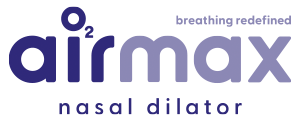Considerable reduction of snoring in 74% of the cases.
Source reference
Prof. Viacheslav G. Merkulov MD, PhD , Prof. Gilbert J. Nolst Trenité MD, PhD (2010)
Non-invasive method of snoring treatment and OSAS prophylactic
Background
The aim of the study is to evaluate the therapeutic efficacy of the intranasal dilator ‘Airmax’ on patients with snoring and OSAS.
Methodology
In the evaluation both models of the Airmax (developed and manufactured in the Netherlands) were used . The devices provide simultaneous dilation of the nasal vestibule and anteroinferior segment of the nasal cavity. Such placement of the device causes the lateral displacement of the nasal alae and lateral walls of the nasal cavity together with the anterior portion of the inferior nasal turbinate. Said dilation offers the enlargement of the common nasal passage and the nasal valve and, hence, increases air flow whilst decreasing impedance produced by intranasal structures while breathing in.
The BREAS system (Sweden) was used to carry out respiratory monitoring (RM), both with and without intranasal dilators. All patients and their bed partners filled in a questionnaire to estimate the quality of sleep with and without the Airmax. Some patients were subjected to rhinomanometry (HRR 3 4-Phase-Rhinomanometer, Germany) and thermistography (developed by Airmax itself).
All patients were considered to manifest the following pathologies: provocative snoring and OSAS, as: hyperplasia of the palatal and lingual tonsils, micrognathia and deviation of nasal septum.
(Endovideorhinopharyngoscopy with functional probes carried out on patients lying on the back).
Results
Considerable reduction of snoring (loudness and duration) was revealed in:
Stage I snorers in 29 cases.
Stage II snorers in 28 cases.
Stage III snorers in 25 cases.
In OSAS in 19 patients.
Very little effect was observed in patients with hyperplasia of the palatal and lingual tonsils, micrognathic patients, and in individuals with blocked posterior part of the nasal cavity (polyposis, fixed deformity of the ploughshare bone, hyperplasia of the posterior end of inferior turbinates).
Conclusion
The single use of the Airmax improves nasal breathing without surgery in several kinds of pathology in the front parts of the nasal cavity, the lower nasal shells and also the vestibule of the nose and can be used as non-invasive method to diminish the loudness and duration of essential stages of snoring (including pregnant women), and prevent the development of OSAS.
